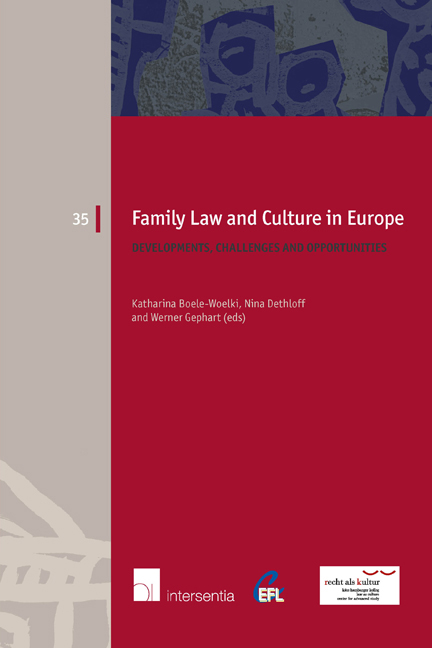Book contents
- Frontmatter
- Preface
- Contents
- List of Authors
- PART ONE THE CEFL PRINCIPLES ON PROPERTY RELATIONS BETWEEN SPOUSES
- PART TWO BREAKUP OF (NON-)FORMALISED RELATIONSHIPS
- PART THREE NEW CONCEPTS OF PARENTAGE
- The Right of the Child to Parents
- Contracting on Parentage
- Biological and Social Parenthood
- France: Biological and Social Parentage
- Anonymous Relinquishment and Baby-Boxes: Life-Saving Mechanisms or a Violation of Human Rights?
- Cross-Border Surrogacy: Time for a Convention?
- Re-Thinking Family Law: A New Legal Paradigm for Stepfamilies?
- PART FOUR INTERNATIONAL FAMILY RELATIONSHIPS
- PART FIVE TRANSNATIONAL FAMILIES: ACROSS NATIONS AND CULTURES
- EUROPEAN FAMILY LAW SERIES
Anonymous Relinquishment and Baby-Boxes: Life-Saving Mechanisms or a Violation of Human Rights?
from PART THREE - NEW CONCEPTS OF PARENTAGE
Published online by Cambridge University Press: 22 November 2017
- Frontmatter
- Preface
- Contents
- List of Authors
- PART ONE THE CEFL PRINCIPLES ON PROPERTY RELATIONS BETWEEN SPOUSES
- PART TWO BREAKUP OF (NON-)FORMALISED RELATIONSHIPS
- PART THREE NEW CONCEPTS OF PARENTAGE
- The Right of the Child to Parents
- Contracting on Parentage
- Biological and Social Parenthood
- France: Biological and Social Parentage
- Anonymous Relinquishment and Baby-Boxes: Life-Saving Mechanisms or a Violation of Human Rights?
- Cross-Border Surrogacy: Time for a Convention?
- Re-Thinking Family Law: A New Legal Paradigm for Stepfamilies?
- PART FOUR INTERNATIONAL FAMILY RELATIONSHIPS
- PART FIVE TRANSNATIONAL FAMILIES: ACROSS NATIONS AND CULTURES
- EUROPEAN FAMILY LAW SERIES
Summary
In the past 15 years in Europe, there has been an increasing trend towards the provision of mechanisms for the anonymous relinquishment of children to the care of the state. Anonymous birth or ‘baby-boxes’ are now available in many European countries, raising important questions concerning the right of children to life, to family and to identity.
This chapter will analyse the practice of anonymous relinquishment throughout Europe, and propose a solution to this difficult social and legal dilemma that will protect the children involved, without placing unnecessary and potentially harmful burdens on mothers. It will show that a balance is needed, placing the best interests of the child as the primary consideration, but also respecting the balance that must be achieved between children, their parents, and the state.
ANONYMOUS RELINQUISHMENT OF CHILDREN: WHAT IS IT, AND WHERE IS IT PRACTISED?
Anonymous birth is traditionally the practice by which mothers can give birth in a hospital without stating their identity, and the child is then placed for adoption. While France is the most prominent exponent of this practice, it is also legal in Luxembourg and Austria. Other European countries also incorporate secrecy not simply as a facet of the adoption process, when fi les are sealed, but at the time of birth. In Italy there is no requirement that the mother be entered onto the birth certificate of the child, and in the Czech Republic and Greece, although the mother's identity is recorded, the birth records can be kept secret.
In addition to anonymous birth, in recent years there has been an increasing trend towards the creation of ‘baby-boxes’ throughout Central and Eastern Europe, which allow parents to leave children in the care of the state anonymously. This practice dates back to the 12th century in Italy, where Pope Innocent II installed foundling wheels in orphanages to prevent the more common practice of women drowning their unwanted children in the River Tiber. In modern times, baby-boxes more commonly take the form of an incubated crib in a hospital or child welfare centre. When a child is placed in the crib, a bell is rung, and the mother can leave anonymously before a carer comes to take the child.
- Type
- Chapter
- Information
- Family Law and Culture in EuropeDevelopments, Challenges and Opportunities, pp. 185 - 198Publisher: IntersentiaPrint publication year: 2014

